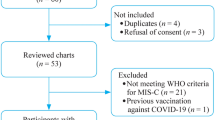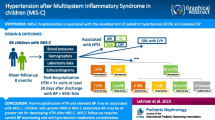Abstract
Multisystem inflammatory syndrome in children (MIS-C or PIMS-TS) is a severe disease. N-terminal pro-B-type natriuretic peptide (NT-proBNP) is used for positive and differential diagnosis, diagnosis of complications and severity, and cardiogenic shock prediction. However, contrasting cut-offs have been suggested. The aims of the present study were to compare NT-proBNP values depending on the time of measurement and to describe the NT-proBNP course during the MIS-C episode. The data from a single-centre cohort observational study on the impact of time to diagnosis, defined as the time from first symptom to diagnosis of MIS-C, were used for the purpose of this study, with an extended period of inclusion from May 2020 to April 2023. The timing and level of all NT-proBNP samples available for each patient were retrospectively collected. Thirty-seven children (18 (49%) females, median age 8.8 years, 14 (38%) with shock) were included. Until diagnosis, NT-proBNP increased with time and was significantly higher at 6 days from first symptoms than at 3 days (median (interquartile range) 32,933 (7773–61,592) versus 1994 (1291–4190) pg/mL, respectively, p = 0.031). From diagnosis, NT-proBNP decreased by at least 50% after 3.0 (2.1–5.3) days (n = 12) when NT-proBNP at diagnosis was low ≤ 11,000 pg/mL versus 1.8 (0.7–3.4) days (n = 16) when NT-proBNP at diagnosis was high (p = 0.040), and after 3.6 (2.4–5.9) days (n = 7) when fever persisted after 48 h versus 1.8 (0.8–3.0) days (n = 21) when fever resolved before 48 h (p = 0.004).
Conclusions: During the MIS-C episode, NT-proBNP increased over time until diagnosis and treatment. It dropped faster thereafter in children with high NT-proBNP at diagnosis > 11,000 pg/mL and slower in case of persistent fever.
What is Known: • NT-proBNP is useful in MIS-C for positive and differential diagnosis, diagnosis of complications and severity, and cardiogenic shock prediction. • Contrasting cut-offs for differential diagnosis and severity assessment have been suggested. | |
What is New: • Before diagnosis, NT-proBNP increases with time and is significantly higher at 6 days from first symptoms than at 3 days suggesting different cut-offs depending on the timing of measurement. • From diagnosis and treatment initiation, the 50% NT-proBNP drop occurs earlier in children with high NT-proBNP at diagnosis > 11,000 pg/mL and later in children with persistent fever. |





Similar content being viewed by others
Data availability
The datasets generated during and/or analysed during the current study are available from the corresponding author on reasonable request.
Abbreviations
- COVID-19:
-
Coronavirus disease 19
- CRP:
-
C reactive protein
- IV:
-
Intravenous
- MIS-C:
-
Multisystem inflammatory syndrome in children
- NT-proBNP:
-
N-terminal pro-B-type natriuretic peptide
- WHO:
-
World Health Organization
References
Alsaied T, Tremoulet AH, Burns JC, Saidi A, Dionne A, Lang SM et al (2021) Review of cardiac involvement in multisystem inflammatory syndrome in children. Circulation 143:78–88
Ganguly M, Nandi A, Banerjee P, Gupta P, Sarkar SD, Basu S et al (2022) A comparative study of IL-6, CRP and NT-proBNP levels in post-COVID multisystem inflammatory syndrome in children (MISC) and Kawasaki disease patients. Int J Rheum Dis 25:27–31
Fridman MD, Tsoukas P, Jeewa A, Yeung RSM, Gamulka BD, McCrindle BW (2023) Differentiation of COVID-19-associated multisystem inflammatory syndrome from Kawasaki disease with the use of cardiac biomarkers. Can J Cardiol 39:815–823
Rodriguez-Gonzalez M, Castellano-Martinez A (2022) Age-adjusted NT-proBNP could help in the early identification and follow-up of children at risk for severe multisystem inflammatory syndrome associated with COVID-19 (MIS-C). World J Clin Cases 10:10435–10450
Zhao Y, Patel J, Huang Y, Yin L, Tang L (2021) Cardiac markers of multisystem inflammatory syndrome in children (MIS-C) in COVID-19 patients: a meta-analysis. Am J Emerg Med 49:62–70
Bichali S, Bonnet M, Lampin ME, Baudelet JB, Reumaux H, Domanski O et al (2023) Impact of time to diagnosis on the occurrence of cardiogenic shock in MIS-C post-COVID-19 infection. World J Pediatr 6:1–10
Alibay Y, Schmitt C, Beauchet A, Dubourg O, Alexandre JA, Boileau C et al (2005) Non-radioimmunometric NT-ProBNP and BNP assays: impact of diluent, age, gender, BMI. Ann Biol Clin (Paris) 63:43–49
Albers S, Mir TS, Haddad M, Läer S (2006) N-Terminal pro-brain natriuretic peptide: normal ranges in the pediatric population including method comparison and interlaboratory variability. Clin Chem Lab Med 44:80–85
Ouldali N, Toubiana J, Antona D, Javouhey E, Madhi F, Lorrot M et al (2021) Association of intravenous immunoglobulins plus methylprednisolone vs immunoglobulins alone with course of fever in multisystem inflammatory syndrome in children. JAMA 325:855–864
Vukomanovic V, Krasic S, Prijic S, Ninic S, Popovic S, Petrovic G et al (2021) Recent experience: corticosteroids as a first-line therapy in children with multisystem inflammatory syndrome and COVID-19-related myocardial damage. Pediatr Infect Dis J 40:e390–394
Lau CS, Liang YL, Phua SK, Murtagh G, Hoefer IE, Stokwielder RH et al (2022) Performance of the Abbott architect immuno-chemiluminometric NT-proBNP assay. Diagnostics (Basel) 12:1172
Lewis LK, Raudsepp SD, Yandle TG, Frampton CM, Palmer SC, Troughton RW et al (2013) Comparison of immunoassays for NTproBNP conducted on three analysis systems: Milliplex, Elecsys and RIA. Clin Biochem 46:388–390
Moreews M, Le Gouge K, Khaldi-Plassart S, Pescarmona R, Mathieu AL, Malcus C et al (2021) Polyclonal expansion of TCR Vbeta 21.3+ CD4+ and CD8+ T cells is a hallmark of multisystem inflammatory syndrome in children. Sci Immunol 6:eabh1516
Belhadjer Z, Méot M, Bajolle F, Khraiche D, Legendre A, Abakka S et al (2020) Acute heart failure in multisystem inflammatory syndrome in children in the context of global SARS-CoV-2 pandemic. Circulation 142:429–436
Dhaliwal M, Raghunathan V, Maheshwari P, Chugh K, Pal H, Satija M et al (2022) Severity and cardiac involvement in multisystem inflammatory syndrome in children. Indian J Pediatr 89:1040–1044
Bichali S, Malorey D, Benbrik N, Le Gloan L, Gras-Le Guen C, Baruteau AE et al (2020) Measurement, consequences and determinants of time to diagnosis in children with new-onset heart failure: a population-based retrospective study (DIACARD study). Int J Cardiol 318:87–93
Schmitz A, Wood KE, Badheka A, Burghardt E, Wendt L, Sharathkumar A et al (2022) NT-proBNP levels following IVIG treatment of multisystem inflammatory syndrome in children. Hosp Pediatr 12:e261–265
Abrams JY, Oster ME, Godfred-Cato SE, Bryant B, Datta SD, Campbell AP et al (2021) Factors linked to severe outcomes in multisystem inflammatory syndrome in children (MIS-C) in the USA: a retrospective surveillance study. Lancet Child Adolesc Health 5:323–331
McCrindle BW, Rowley AH, Newburger JW, Burns JC, Bolger AF, Gewitz M et al (2017) Diagnosis, treatment, and long-term management of Kawasaki disease: a scientific statement for health professionals from the American Heart Association. Circulation 135:e927–999
Henderson LA, Canna SW, Friedman KG, Gorelik M, Lapidus SK, Bassiri H et al (2022) American College of Rheumatology clinical guidance for multisystem inflammatory syndrome in children associated with SARS-CoV-2 and hyperinflammation in pediatric COVID-19: version 3. Arthritis Rheumatol 74:e1–20
Ptak K, Szymońska I, Olchawa-Czech A, Kukla K, Cisowska M, Kwinta P (2023) Comparison of the course of multisystem inflammatory syndrome in children during different pandemic waves. Eur J Pediatr 182:1647–1656
Acknowledgements
We acknowledge the patients and their family, as well as the teams who took part to their care.
Funding
Naïm Ouldali was funded by the ReCH-MIE Grant n°RECHMIE-22–0004 from the Ministry of Health and Prevention. The other authors declare that no funds, grants, or other support were received during the preparation of this manuscript.
Author information
Authors and Affiliations
Contributions
S.B. conceptualized and designed the study, coordinated data collection, carried out the initial analyses, performed interpretation of data, drafted the initial manuscript, and critically reviewed and revised the manuscript. N.O., F.G., P.M., A.H., and S.L. critically reviewed and revised the manuscript.
Corresponding author
Ethics declarations
Ethical approval
This study was performed in line with the principles of the Declaration of Helsinki and was validated by the local ethics committee in agreement with French regulations for such observational studies.
Consent to participate
Informed consent was obtained from all individual participants included in the study or their parent or legal guardian.
Competing interests
The authors have no relevant financial or non-financial interests to disclose.
Additional information
Publisher's Note
Springer Nature remains neutral with regard to jurisdictional claims in published maps and institutional affiliations.
Rights and permissions
Springer Nature or its licensor (e.g. a society or other partner) holds exclusive rights to this article under a publishing agreement with the author(s) or other rightsholder(s); author self-archiving of the accepted manuscript version of this article is solely governed by the terms of such publishing agreement and applicable law.
About this article
Cite this article
Bichali, S., Ouldali, N., Godart, F. et al. NT-proBNP course during MIS-C post-COVID-19: an observational study. Eur J Pediatr 183, 1667–1674 (2024). https://doi.org/10.1007/s00431-023-05353-x
Received:
Revised:
Accepted:
Published:
Issue Date:
DOI: https://doi.org/10.1007/s00431-023-05353-x




